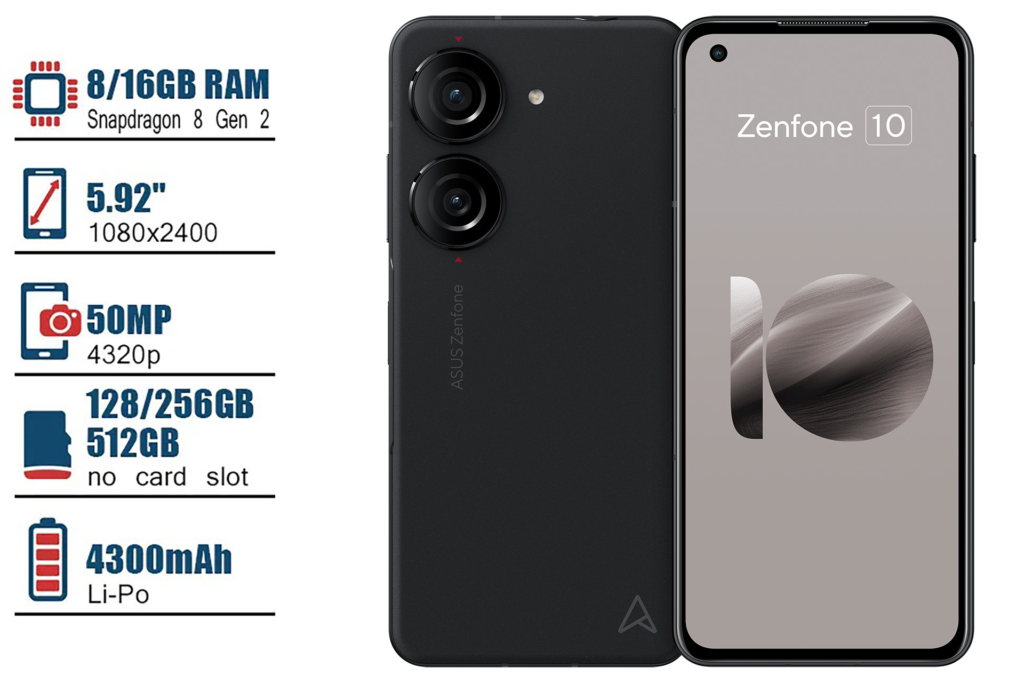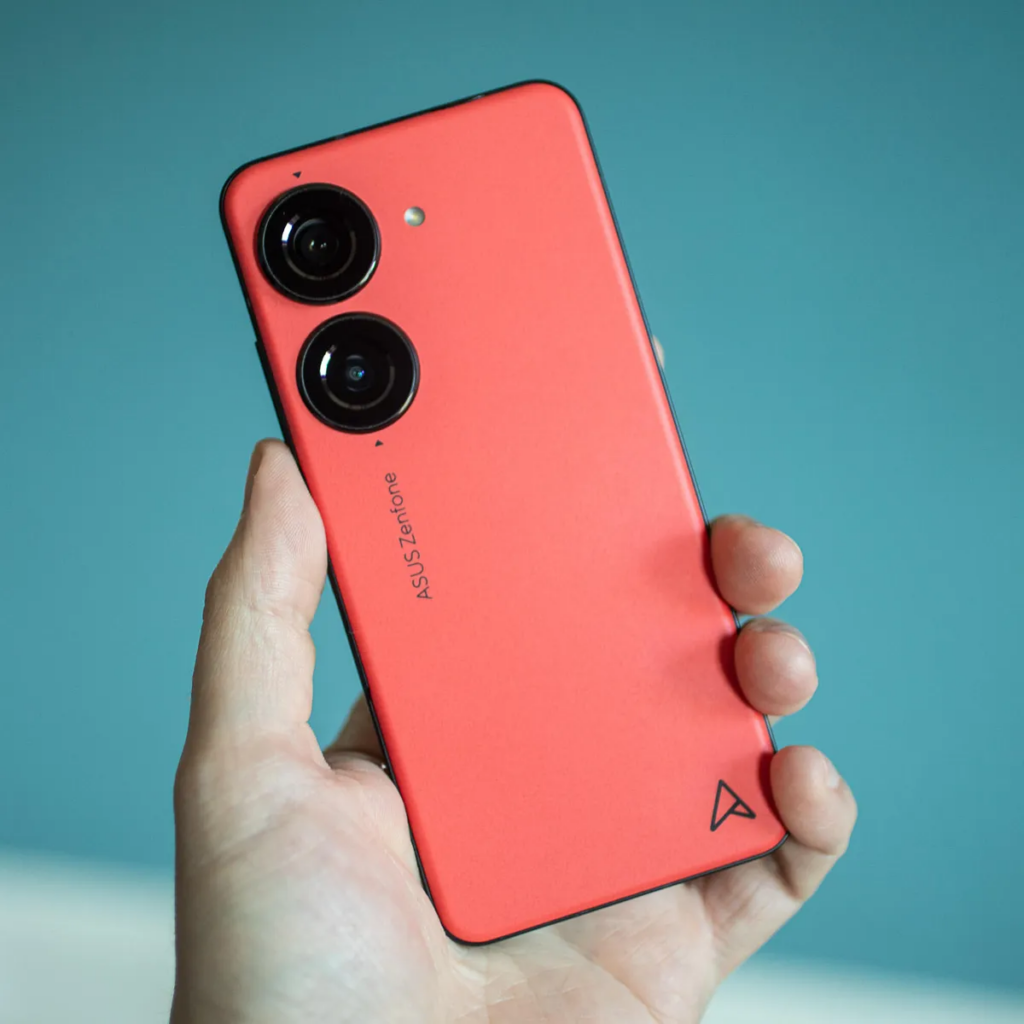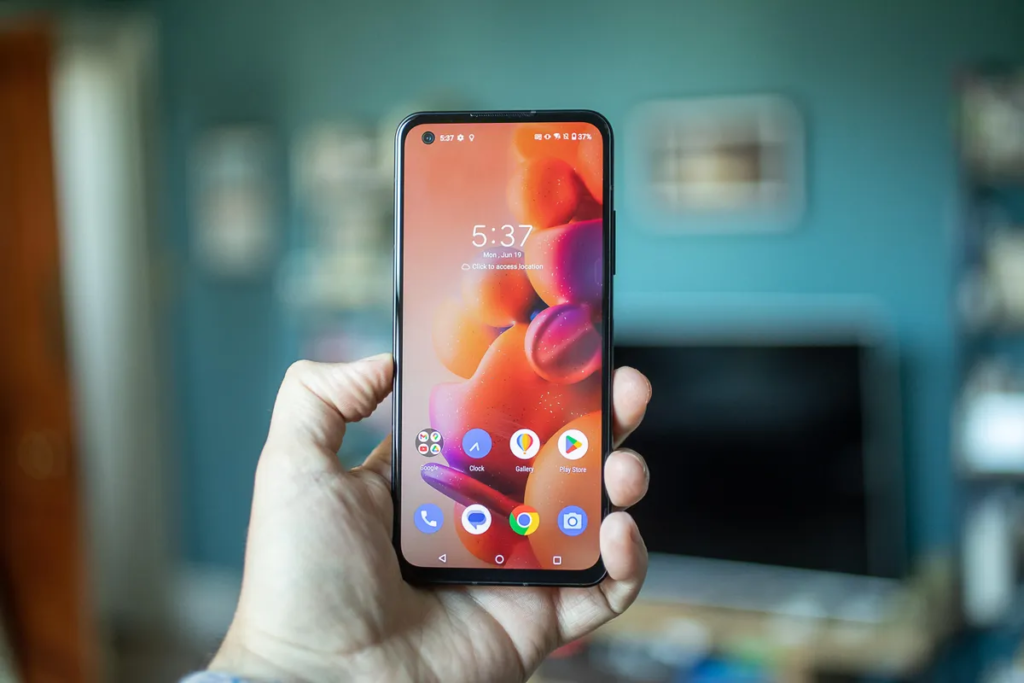The Asus Zenfone 10 brings iterative upgrades, including a couple of small improvements (alongside a few minor setbacks). However, many issues and questionable choices from the Zenfone 9 remain unaddressed – the pricing is high relative to the offering, the chipset’s power is somewhat excessive, and the camera and charging speed deliver satisfactory performance at best. If you’re specifically seeking a compact mobile device, it’s worth contemplating; otherwise, it’s advisable to explore other options.
Advantages:
+Compact size
+Enhanced selfie experience
+Attractive color choices
Disadvantages:
-Size may be limiting for some purposes
-High pricing
-Minimal deviations from Zenfone 9’s features.
Asus Zenfone 10 Quick Review
The Asus Zenfone 10 stands alone as this year’s sole small phone release, reluctantly earning the ‘best’ small phone title due to lack of competition.
Asus faces a recurring challenge with its Zenfone mini Android line: How to navigate a world of ever-expanding mobiles while championing a compact device?
The Asus Zenfone 10 offers few changes from its predecessor, the Zenfone 9, sporting slight spec tweaks and a higher price tag. It caters to one-handed use but fails to secure a spot among the top Android phones.
Much like a skilled chef using budget ingredients, Asus holds a strong recipe for Zenfone mobiles, but something’s amiss. Despite the demand for compact phones, the Zenfone 10’s mix of premium features (expensive chipset, high price) and less impressive ones (camera, design, slow charging) results in a ‘jack of no trades.

Consider the chipset. Asus consistently inserts the latest Snapdragon chips into Zenfone models, seemingly great for gaming – until their small screens hinder gameplay.
The price, $699.99 / £749.99 (about AU$1,450), puts the Zenfone 10 against the iPhone 14 and Samsung Galaxy S22. With weaker cameras and a less impressive screen, it falls short.
Asus maintains underwhelming specs in other aspects, from the camera array resembling mid-range phones to sluggish charging.
For a small phone, options are limited. The sub-6-inch market offers Zenfone or iPhone SE, leaving Android fans with few choices.
While this review leans negative, the Zenfone 10 has redeeming qualities. Its compact size facilitates one-handed use and effortless portability.
Improvements include a notably better front camera and enhanced selfie experience. Wireless charging and vibrant color options add appeal. However, the question lingers: Are extra colors, megapixels, and charging methods worth the higher cost?
Why Asus avoids positioning Zenfone as an attractive mid-range option remains a mystery. With trimmed specs and a lower cost, the Zenfone 10 could thrive. Regrettably, that’s not the case.
Asus Zenfone 10 Review: Price and availability

Available in the UK & Europe since July 31
Pre-orders in the US starting from August 22
Australian availability is yet to be confirmed
Starting at $699.99 (128GB) / £749.99 (256GB)
After its unveiling on June 29, 2023, the Asus Zenfone 10 was released in Europe (including the UK) on July 31. Pre-orders began in the US on August 22, and an Australian launch is pending confirmation.
The phone is priced at $699.99 (approximately £550 / AU$1,090) for the base 8GB RAM / 128GB storage variant (apparently exclusive to the US), $749.99 / £749.99 (about AU$1,450) for the 256GB storage option, and $799.99 / £819.99 (around AU$1,550) for the top-tier 16GB RAM / 512GB model. Our review unit was the fully loaded Aurora Green variant, though white, black, red, and blue choices are also available.
Asus Zenfone 10 pricing:
RAM / Storage | US price | UK price
8GB / 128GB | $699.99 | N/A
8GB / 256GB | $749.99 | £749.99
16GB / 512GB | $799.99 | £819.99
For comparison, the Asus Zenfone 9 started at $699 / £699 / AU$1,199 for 8GB / 128GB and $799 / £749 (around AU$1,300) for 16GB / 256GB variant. Each RAM model sees a slight price increase compared to the previous year. While this could be justified by added storage and features, it brings the Zenfone closer in price to top-tier competitors.
The Android leader, Samsung Galaxy S23, is priced at $799.99 / £849 / AU$1,349, and the iPhone 14 is priced at $799 / £849 / AU$1,339, both for base models. This narrows the price gap with the Asus, moving it from ‘mid-range’ to ‘premium’, albeit on the more affordable side.
- Value rating: 3.5 / 5
Asus Zenfone 10 Review: SPECS
The Zenfone 10 packs ample power, perhaps more than it’ll ever fully utilize. Nonetheless, it’s reassuring that this compact smartphone offers excess capacity to tackle whatever you throw at it.

Asus Zenfone 10 specifications:
- Dimensions: 146.5 x 68.1 x 9.4mm
- Weight: 172g
- Display: 5.9-inch 20:9 FHD+ (2400×1080) 144Hz Samsung AMOLED, shielded by Gorilla Glass Victus
- Chipset: Qualcomm Snapdragon 8 Gen 2
- RAM: 8GB / 16GB (LPDDR5X)
- Storage: 128GB / 256GB / 512GB (UFS 4.0)
- OS: Android 13 with ZenUI
- Main camera: 50MP, f/1.9 with six-axis ‘Hybrid Gimbal Stabilizer 2.0’
- Ultra-wide camera: 13MP with 120º FoV
- Front camera: 32MP
- Audio: Stereo speakers, 3.5mm headphone jack
- Battery: 4,300mAh
- Charging: 30W wired, 15W wireless
- Color options: Midnight Black, Comet White, Eclipse Red, Aurora Green, Starry Blue
Asus Zenfone 10 Review: Design
- One of the few standout compact phones available
- IP68 certified for durability
- Includes a rare 3.5mm headphone jack
- Comes in various color options

The Asus Zenfone 10 closely resembles the Zenfone 9, with the only significant change being the camera system’s design. I didn’t notice this minor alteration until the company pointed it out.
The phone’s focal point is its size. Measuring 146.5 x 68.1 x 9.4mm, it stands as one of the market’s smallest modern mobiles, rivaled only by the iPhone SE. Its light weight of 172g adds to its appeal.
These dimensions make one-handed use effortless, with nearly the entire display and the buttons along the right edge easily accessible. These buttons encompass the volume rocker and power button, with the latter integrated into a side-mounted fingerprint scanner that consistently recognized my thumbprint during testing.
In theory, the size should provide exceptional comfort, but Asus embraces the flat-edge phone trend that has gained popularity in recent years (despite its ergonomic implications). Consequently, the handset’s corners press into the palm and fingers slightly while holding.
Charging is facilitated through a USB-C port, and a 3.5mm headphone jack remains, making the Zenfone a rare haven for wired audio enthusiasts (joining the likes of the Sony Xperia 1 V).
For those valuing robust protection, the Zenfone offers an IP68 rating against water and dust. While the plastic frame might not exude a premium feel, it’s certainly more durable than glass.
Notably, the Asus Zenfone 10 provides an array of color choices, defying the mundane phone color trend. Our test unit was Aurora Green, though Asus’ images suggest that red is the vibrant standout option.
- Design rating: 3.5 / 5
Asus Zenfone 10 Review: Display
- Features a 5.9-inch Full HD+ display
- Refresh rate boosted to 144Hz (up from 120Hz on Zenfone 9)
- Small screen size may hinder the gaming experience

With a compact body comes a smaller 5.9-inch display – among the tiniest in current-gen smartphones. The screen maintains a consistent 1080 x 2400 Full HD+ resolution from Zenfone’s recent generations.
A noteworthy enhancement lies in the refresh rate, now elevated to 144Hz, ensuring smoother motion with the screen refreshing 144 times per second. However, this enhancement is limited to gaming scenarios, not everyday usage, leaving non-gamers unable to fully capitalize on it.
Choosing a 5.9-inch screen for gaming raises questions, as the display isn’t spacious enough for optimal detail visibility. Icons crowding the screen and fingers obstructing the view can leave users yearning for a larger display.
- Display rating: 3.5 / 5
Asus Zenfone 10 Review: Software
- Zen UI over Android 13 out of the box
- Noteworthy addition of Smart Key
- Assured two years of OS updates, four years of security updates

Similar to many Android phone manufacturers, Asus adds its own interface layer to stock Android. The Zenfone 10 runs Android 13 with Zen UI enhancements.
Unlike certain Android modifications, Zen UI is a subtle makeover. It’s easy to mistake the Zenfone 10 for running stock Android, as Asus allows users to choose between its features and Android’s alternatives.
Zen UI offers a revamped volume slider, distinctive call display, restructured quick settings panels, and more. However, most alterations are cosmetic.
A significant addition is the Smart Key feature, which enables the activation of various functions through double taps or holding the side power key. Yet, this proved less dependable than conventional methods for tasks like checking notifications or skipping songs.
For those concerned about support duration, Asus confirms the Zenfone 10 will receive two years of OS updates (up to Android 15) and an additional two years for security patches.
- Software rating: 4 / 5
Asus Zenfone 10 Review: Cameras
- 50MP main + 13MP ultra-wide setup
- 32MP front camera (up from 12MP on predecessors)
- Enhanced AI image processing, no ultra-wide autofocus

The Asus Zenfone 10 brings modifications, though they’re hard to dub as straightforward ‘upgrades.’ More like side steps?
The main camera resembles the Zenfone 9’s: a 50MP f/1.9 shooter employing the popular Sony IMX766 sensor. A reliable mid-range sensor that captures light effectively, delivering vibrant images found in budget and mid-range devices.
The captured photos exhibit satisfying richness, decent contrast, and saturation. Asus appears to have refined its AI image processing from prior models.
Accompanying the main camera is a 13MP ultra-wide lens with a 120-degree field of view. It boasts slightly higher resolution and wider coverage compared to last year, yet bafflingly lacks autofocus – an oversight considering some users utilize ultra-wide cameras for macro shots.
A more noticeable setback emerges with this camera: images appear desaturated and flat compared to the main camera, losing vibrancy.
There are merely two rear cameras here – a misstep from Asus, possibly influenced by the iPhone’s approach. This omission disappoints users seeking a versatile photographic experience, lacking a macro or telephoto lens.
Front and center, the camera hardware sees a substantial transformation. The past year’s 12MP selfie camera gives way to a 32MP sensor. This brings a significant improvement in selfie quality, not only due to higher resolution for enhanced editing but also benefiting from upgraded Portrait mode and AI processing. Here, Asus has made commendable strides in enhancement.
Video recording tops at 8K/24fps or 4K/60fps, and slow-motion enthusiasts can embrace 4K/120fps, FHD/240fps, or HD/480fps. The Camera app offers standard modes like time-lapse, portrait, light trails, Pro, and night mode.
Kindly note that the two selfie camera samples were cropped to 1:1 for successful uploading. By default, the phone captures in 4:3.

- Camera score: 3.5 / 5
Asus Zenfone 10 Review: Performance and Audio
- Snapdragon 8 Gen 2 is excessive for this size
- Gaming is smooth yet cramped
- Flexible audio experience
The Asus Zenfone 10’s chipset, the Snapdragon 8 Gen 2, is the most potent processor available for Android phones, common in top models. Asus consistently employs leading chips, and the Zenfone 10 follows suit.
However, this level of power is overly abundant for such a device. Due to its small screen, using the Zenfone for demanding tasks like gaming or photo editing proves challenging, even though a 16GB RAM variant is available.
Testing Call of Duty Mobile and PUBG Mobile exposed several issues. Default on-screen icons are too tiny for prompt presses, and resizing only partly alleviates this. Additionally, hands obstructed the screen, thumbs collided during actions, and short gaming sessions resulted in hand cramps due to the device’s small size. Gaming on this mobile proved challenging, despite Asus being a leader in gaming phones.
Considering gameplay minus human limitations, games perform well – activating the 144Hz screen setting and highest graphics options enables the Asus to handle games smoothly (except for Qualcomm Snapdragon chipsets’ persistent overheating problem). However, this prowess is lost if the screen is barely visible.
Recurring complaints about the Zenfone’s puzzling chipset choice persist – a Snapdragon 7-series chipset would lower the phone’s price, eliminate overheating issues, and have negligible impact on user experience.
Regarding audio, the built-in speakers suffice, and with a 3.5mm headphone jack and Bluetooth connectivity, users can opt for their own headphones.
- Performance rating: 3.5 / 5
Asus Zenfone 10 Review: Battery life
On most phones, a 4,300mAh battery might raise concerns. Such a mid-sized battery typically struggles to support a device with a high-end chip, 5G connectivity, and a high-refresh-rate display for a long. Luckily, the Zenfone’s compact screen mitigates this issue, resulting in a fairly typical battery life.
In our testing, the Zenfone 10 comfortably lasted a full day without needing a recharge – the norm for an average mobile. While it won’t endure for two days (a feat few phones achieve), you won’t worry about it dying within a single day.
Charging transpires through the USB-C port at 30W, relatively slow compared to other Android phones. It takes at least an hour to reach full power. The addition of wireless charging at 15W is noteworthy. Though not rapid, it’s a valuable extra for users who prefer charging docks or pads.
Having tested numerous large phones that pose challenges on wireless charging stands, the Zenfone’s size made it conveniently adaptable to various chargers.
- Battery rating: 4 / 5
Leave a Reply